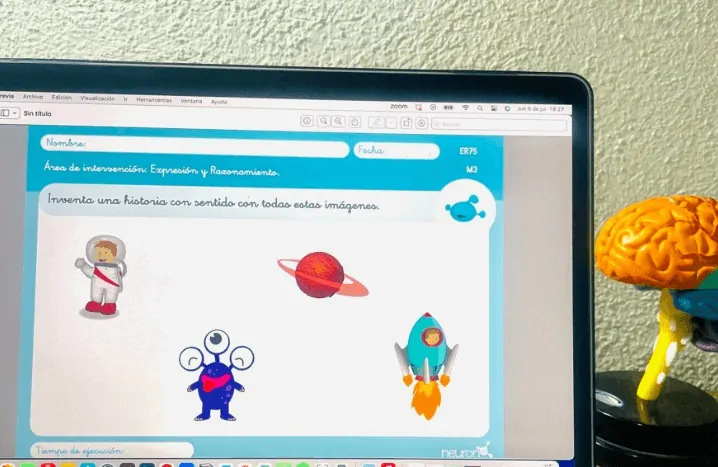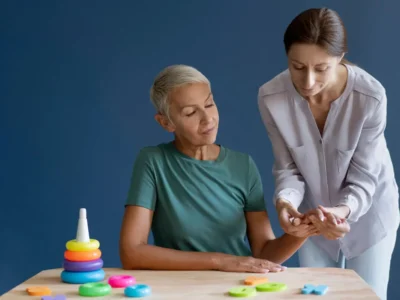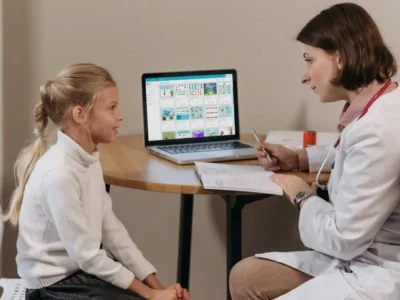Today we bring you a set of motivating activities to improve cognitive development in children. With the different games you can work on: selective attention, reasoning, semantic memory, vocabulary, time estimation and visual gnosias, among others.
1. Search and you will find!
The first of NeuronUP’s motivating activities for children that we suggest is Search and you will find!
What does it involve?
Children have to search for a series of specific items within a group. But watch out!, it’s more complex than it seems because the objects are piled up.
In the following medium-level example, the child will have to find the animals indicated at the top and take them to the farm:
What does this activity work on?
This activity to improve children’s cognitive development works on the selective attention.
Play by levels
Remember that you can choose whatever difficulty level you want to adapt the activity to each child’s needs and abilities. The more difficult the level, the harder it will be to find the animals.
Personalizing the activity
General aspects
You will be able to customize: the number of exercises (total, passed, acceptable and failed), the maximum time, the inactivity warning and the timer.
Also, as with all NeuronUP games, Search and you will find! is organized into phases and children will move up or down levels depending on their successes or mistakes.
Parameters
As a professional you will be able to customize the game according to the age and personal abilities of each of your users. In this regard, you will be able to choose:
- The number of elements,
- the number of elements to search for,
- maximum errors.
Adaptability
You can also choose adaptability. That is, whether you want the child to perform this activity by dragging or tapping.
2. Make Up a Story with Pictures
The Make Up a Story with Pictures exercise improves cognitive development in children.
What does it involve?
Make Up a Story with Pictures is a paper activity; it consists of creating a story by linking several given elements. We put creativity and imagination to the test!
For example, in the following worksheet the children have to invent a story that includes some balloons, a present and a birthday cake.

What does this activity work on?
This worksheet works primarily on reasoning and secondarily on expression.
Play by levels
Remember that to make the activity motivating for children you can choose whatever difficulty level you want to adapt the activity to each child’s needs and abilities. The more difficult the level, the more elements there will be to create the story.

Subscribe
to our
Newsletter
3. Tidy Up the Mess
What does it involve?
The child has to match the images with their corresponding categories.
Also, the categories are related to everyday life elements: leisure, clothing, musical instruments, animals, school supplies, etc.
Watch the following video for an example of how to play Tidy Up the Mess:
What does this activity work on?
This activity works on semantic memory, which is where we store general information about the world.
Format
Tidy Up the Mess is also available in paper format, as well as digital.
Application in daily life
Semantic memory is fundamental for being able to manage in our daily lives. For example, that children know when they go to the supermarket to buy bread that they have to go to the bakery section or that they know how to organize their clothes logically to later find the garment they want.
Personalizing the activity
You will be able to customize the activity to suit each child’s individual needs and abilities.
General aspects
You can adjust general aspects such as the mode of operation, the maximum time, whether or not the timer is visible for the activity and an inactivity warning, modify the instructions, etc.
Parameters
And, on the other hand, the parameters, where you can select the number of elements.
5. The Word Guardian
What does it involve?
The Word Guardian is a game in which children have to discover the hidden word by pressing the letters they want. Watch out, every time they make a mistake, a piece of the tower will fall!
What does this activity work on?
This activity works on vocabulary and working memory.
Play by levels
Remember that you can choose whatever difficulty level you want to adapt the activity to each child’s needs and abilities. The more difficult the level, the harder the words to discover.
Watch the following video to see how to play The Word Guardian:
Personalizing the activity
You will be able to customize the activity to adapt it to each child’s individual needs and abilities:
General aspects
You can adjust general aspects such as the number of exercises, the maximum time, whether or not the timer is visible for the activity and an inactivity warning, modify the instructions, etc.
Parameters
And, on the other hand, the parameters, where you can select:
- The number of hints,
- the letters provided,
- the cultural level: very low, low, medium, high or very high,
- letter format: uppercase or lowercase. A very useful parameter for children who still do not recognize all the letters well.
7. How much time does it take?
What does it involve?
This children’s time estimation worksheet consists of organizing different activities in a schedule taking into account the time it would take to do them.
We show you an example in the following video:
What does this activity work on?
- The main function this activity works on is time estimation. Sometimes we find it difficult to calculate how long things might take and that means we don’t organize ourselves well.
- Planning is also worked on , since being able to plan is fundamental to organizing tasks. In this case, the planning component is not very high, because children do not yet have that ability very developed, but it is important that they practice it.
Play by levels
Remember that you can choose whatever difficulty level you want to adapt the activity to each child’s needs and abilities. The more difficult the level, the more activities will have to be organized in the schedule.
8. Shape Sorter
Another of NeuronUP’s motivating activities for children that we propose is Shape Sorter.
What does it involve?
In this activity, the child has to fit the pieces into place according to their shape.
What does this activity work on?
Main function
- Visual gnosias, since they have to identify the shape.
Secondary functions
- Selective attention, since it is about distinguishing one shape from the rest. Also, as the level increases, the shapes will become more and more similar to each other.
Application in daily life
Although many times we don’t even realize it, in every small task we have to carry out we must be able to recognize the elements in front of us.
The basis for this is being able to distinguish basic shapes (circles, squares, triangles…). And, once this point is mastered, we build more complex objects in our minds.
Play by levels
At the simplest levels it will be easier to fit the pieces, since the pieces will be more basic, whereas at the most advanced levels it will be more difficult because the pieces will have very similar shapes and it will be harder to distinguish them at first glance.
Watch the following video to see how to play Shape Sorter:
9. What’s its name?
What does it involve?
Children have to match each noun with the image that represents it.
At lower levels, children will find simple, commonly used words. But as the level increases, they will find more complex terms that are less frequently used in their daily lives.
We show you an example in the following video:
What does this activity work on?
Language is fundamental for children to communicate. And, therefore, it is very important to work on nouns, which help us name everything around us. In the activity What’s its name? children will have to match the names of various elements with their image, thus working on their vocabulary.
Play by levels
Remember that you can choose whatever difficulty level you want to adapt the activity to each child’s needs and abilities. The more difficult the level, the greater the challenge and the more nouns there will be to match with the images.
Format
What’s its name? is available both in digital format and on paper.
If you liked these activities to improve children’s cognitive development, you might also be interested in these articles with more motivating activities for children from NeuronUP:
“This article has been translated. Link to the original article in Spanish:”
Mejora el desarrollo cognitivo en niños: Actividades motivadoras para niños de NeuronUP







 Worksheet for working on visual gnosis in children: Complete the image
Worksheet for working on visual gnosis in children: Complete the image
Leave a Reply